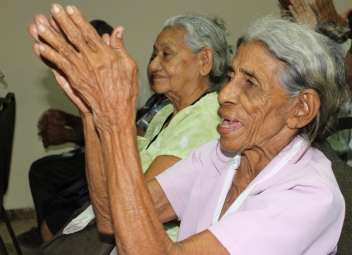 “We thank god we are alive. The illegal armed group came one afternoon and rounded us all up in the main square of the village. I thought: ‘this is it. This is the end’. It is a miracle they did not kill us.
“We thank god we are alive. The illegal armed group came one afternoon and rounded us all up in the main square of the village. I thought: ‘this is it. This is the end’. It is a miracle they did not kill us.
“They gave us 24 hours to pack and leave. The next day not a single person remained. We all fled for our lives.”
These are the words of the old man they call “the teacher”, a community leader with twinkling eyes and a broad smile who took us around the ruins of the village of Mampujan in northern Colombia.
With pride and sorrow he showed us the house where he and then his seven children were born. The house now lies abandoned.
Threats and displacement
Mampujan was one of the many villages whose inhabitants – decent, country folk living off the land – suffered threats and displacement in the early 2000s at the hand of illegal armed groups involved in the civil war that still ravages Colombia.
For three to four years they took refuge in nearby Maria la Baja. No one dared return. After failed attempts at resolving their situation and discrimination from the local population, a priest donated a plot of land to them to rebuild their community close to their original village. And so they were able to rebuild their lives.
“We lived well before, we had our land, grew and sold our produce in local markets, we lived in good houses…now we are poor,” explains “the teacher”. Some have new houses built by the government housing programme, but they are still waiting for the rest. Some of the houses are in poor condition and the village is prone to flooding. The roads are littered with rubbish. They used to have a health post and a primary school, but both lie abandoned in the old town.
New faith in life
The older people of this community have, with HelpAge partner Fundacion Red de Desarrollo y Paz de los Montes de Maria supported by Irish Aid, rebuilt their hope and faith in life. They now know their rights and the government programmes they should have access to.
Older people in Mampujan have set up an older citizens monitoring group to demand compensation. They carried out a census of the older people in their community, ensured that health brigades have a special queue for older people and that there is a list of all the older people entitled to the government’s economic subsidy.
They have repaired and painted their chapel, are lobbying for formal land deeds and the remaining houses to be built. Older people have become a new force for good in the village after years of fear and suffering.
A resource to the community
The impacts of the project are tremendous. In the words of Don Raúl of Caracol, one of the other participating villages: “The project has brought us into the light, showed us that we have rights and that we are a resource for our communities, not a mere cost for the government.”
The communities now have health staff, first aid kits and an ambulance. The economic subsidy for older people is being delivered more effectively and they are better included in community life.
For me personally, this has been a most gratifying visit as I was involved in designing this programme, although I was concerned whether it would be received well by older people in such a difficult context.
However, now I see how empowered the older people are; as well as organised, enthusiastic, dynamic and determined. I am convinced that HelpAge’s rights-based approach and working with local organisations such as the Foundation are both crucial elements in achieving real and lasting change.
I take my hat off to all the older people who have participated in this project and taken it forward, the perseverance of the Foundation’s leadership and staff and the HelpAge office in Colombia. This is development at its best!
Look at our photogallery of older people from Montes de Maria by Louise O’Gorman and Antonio Olmos on the Guardian Development website
Read more about our work with older people in Colombia

